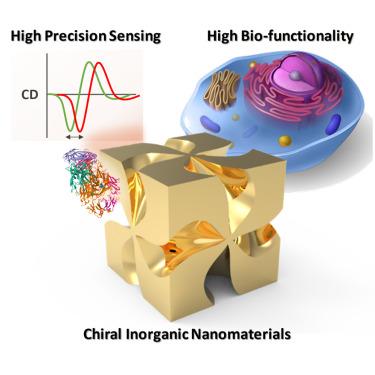Chem ( IF 23.5 ) Pub Date : 2024-01-23 , DOI: 10.1016/j.chempr.2023.12.016 Nam Heon Cho , Hyeohn Kim , Jeong Won Kim , Yae-Chan Lim , Ryeong Myeong Kim , Yoon Ho Lee , Ki Tae Nam

|
The biological relevance of chirality has aroused significant interest for the modulation of pathological and biomedical activity. With a commensurate size scale to the biological environment, chiral inorganic nanomaterials could exhibit enzyme-like properties that dictate the selectivity and directionality of bioactivity. This chirality-dependent functionality originates from handedness-dependent interactions at chiral organic-inorganic interfaces or chiral light-matter interactions, enabling high-precision molecular analysis and high-efficiency biomedical therapy. This perspective provides an overview of biomolecule-driven chiral inorganic nanomaterial synthesis, enantioselective interactions at organic-inorganic interfaces, and biomedical applications for chirality-dependent molecular sensing and therapeutics. A comparison of representative chiral inorganic nanostructures suggests that nanoscale control of chiral features is critical for enhancing the ultimate chirality in inorganic nanomaterials. Therefore, quantitatively understanding chiral organic-inorganic interfaces and more systematically modulating their relationship, such as systematically incorporating sequence-programmable biomolecules (such as DNA or proteins), have been suggested as a potential direction for research into biomedically functional chiral inorganic nanomaterials.
中文翻译:

用于生物医学应用的手性无机纳米材料
手性的生物学相关性引起了人们对病理和生物医学活动调节的浓厚兴趣。凭借与生物环境相称的尺寸尺度,手性无机纳米材料可以表现出类似酶的特性,从而决定生物活性的选择性和方向性。这种手性依赖的功能源于手性有机-无机界面上手性依赖的相互作用或手性光-物质相互作用,从而实现高精度分子分析和高效生物医学治疗。该视角概述了生物分子驱动的手性无机纳米材料合成、有机-无机界面的对映选择性相互作用以及手性依赖性分子传感和治疗的生物医学应用。代表性手性无机纳米结构的比较表明,手性特征的纳米级控制对于增强无机纳米材料的最终手性至关重要。因此,定量理解手性有机-无机界面并更系统地调节它们的关系,例如系统地整合序列可编程生物分子(例如DNA或蛋白质),被认为是生物医学功能性手性无机纳米材料研究的潜在方向。



























 京公网安备 11010802027423号
京公网安备 11010802027423号